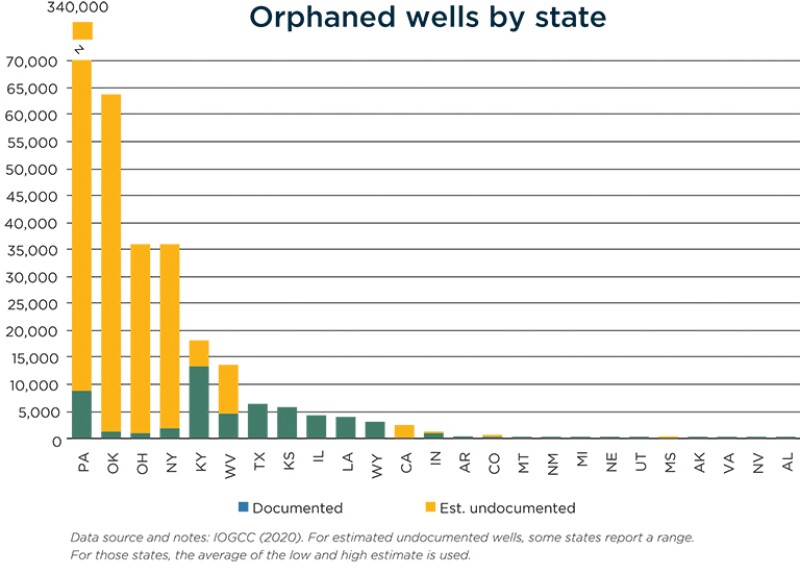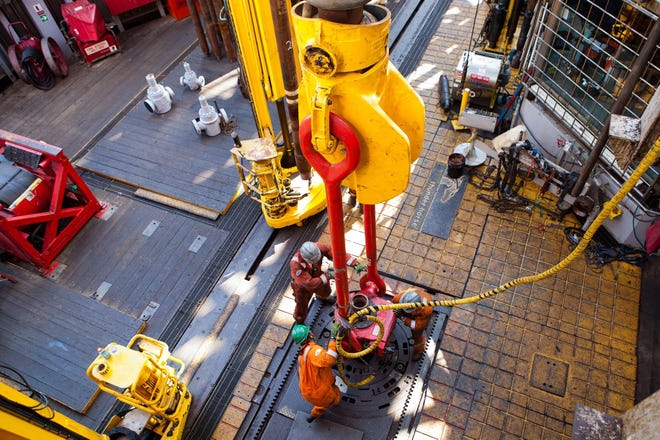What Big Oil’s solar energy projects reveal about its climate strategy
Eric Rosenbaum@ERPROSE
KEY POINTS
Occidental CEO Vicki Hollub says fossil fuels aren’t the problem. It’s carbon emissions.
For oil and gas companies to make that argument stick in a world increasingly skeptical of fossil fuel industry efforts to combat climate change, many climate technologies will have to be pursued.
One is solar power, with Oxy, EOG Resources, ExxonMobil and Chevron all adding to solar energy project deals in recent years.
Solar is not insignificant in lowering emissions from oil operations, but it is far from a de-carbonization strategy.

The oil and gas sector has been experimenting with solar power as a generation source for oil operations for decades, such as this Chevron (then ChevronTexaco) California project in 2003. As costs of solar come down and pressure intensifies on oil companies to cut emissions, more renewable energy will de deployed, but it may remain limited — in scope and effectiveness.
David McNew | Getty Images News | Getty Images
Oil and gas companies are working hard on their messaging in the climate change era. If it’s “code red for humanity” as the UN’s IPCC said last Monday in its latest dire climate report, it’s some sort of “code red” for the fossil fuels industry too, in terms of figuring out how to stay relevant, believable — and for the market, investable — in an era of carbon emissions reduction mandates from governments, regulators and shareholders.
Occidental CEO Vicki Hollub took a stab at it earlier this year, saying fossil fuels aren’t the problem — it’s emissions. It follows that if fossil fuel companies can find ways to eliminate emissions, on a large enough scale, maybe they can convince shareholders and stakeholders that they are moving into the future in more sustainable way.
But there are big differences in emissions types and emissions reduction strategies. What oil and gas companies do to reduce emissions in their operations and supply chain are, in the end, a smaller part of the carbon reduction game than reducing what is known as Scope 3 emissions — for example, from the tailpipe of your car. Those Scope 3 emissions, by expert estimates, are responsible for the vast majority of carbon emissions from the energy industry.
Lowering carbon emissions profile of oil and gas drilling
Companies including ExxonMobil have begun to disclose Scope 3 emissions, but in terms of their efforts to reduce emissions, remain focused on their own operations. What oil and gas companies do to lower operational emissions, the energy used to power drilling and all the way to the trucks going to and from drilling sites, does matter. Though how much it matters is inevitably smaller in the grander scheme of carbon emissions reduction efforts.
“The electricity oil and gas companies use is a pretty small contributor to their carbon footprint,” said Chris Archer, head of Americas for Macquarie Capital’s Green Investment Group.
Occidental has been a leader in many of the new technology approaches to lowering the emissions profile of the oil and gas business. As Hollub told CNBC earlier this year, “The reality of a net-zero carbon barrel, it is possible, and we are doing things to make it possible. It’s not a goal on a sheet of paper.”
Occidental is working on multiple projects related to carbon sequestration, not just for its operations, but other heavy emitters in the industrial sector. A growing but smaller part of that new technology thinking for oil and gas operations, which is expected to see more development in the future, is solar energy — solar panel arrays spreading out in places like the Permian Basin to help lower the emissions profile of oil and gas operations.
Occidental already has a 16 megawatt solar farm in the Permian — the first large-scale solar project to directly power oil and gas operations in Texas — and Hollub told CNBC earlier this year “we will be doing more of that. We believe it will take everything, and we will add more solar over time.”
Oil and gas industry’s history with solar
Solar isn’t a new thing for oil and gas. Chevron had a project powering operations in the Kern oil field of California as far back as 2003, and BP even got into solar panel manufacturing for decades under Sir John Browne’s “Beyond Petroleum” mission (before solar manufacturing became mostly China’s game and most everyone else went bankrupt).
“This isn’t a brand new journey,” said Amy Chronis, leader of Deloitte’s US Oil, Gas & Chemicals team in Houston. “But it’s still early days to see broad-based carbon reductions.”
Now several of the European and U.S. majors are making major investments in renewable again, including BP and Royal Dutch Shell, and all the big oil and gas companies have at least a few solar power projects, whether they developed them on their own or signed what are known as power purchase agreements with project developers, including ExxonMobil, which has added to its renewable energy portfolio in recent years.
It bought 500 megawatts of wind and solar in 2018 from Danish renewable energy company Orsted, the largest renewable deal ever signed by a U.S. major. Chevron signed its own 500 MW project last summer, with the energy generation to be split between the Permian, Argentina and Kazakhstan.
A lot of the renewable energy history within solar has been more fits and starts — and lower down the priority list —than consistent application to the business. Though, the pressure is mounting.
Benjamin Shattuck, research director for Americas upstream oil and gas at energy consulting firm Wood Mackenzie, said most of the companies he follows in the U.S. are still fairly early on in their journey to a carbon reduction model, but as environmental performance and ESG become more mainstream — he said ESG is top of agenda when he talks to oil CEOs lately —and more companies talk about net-zero targets and tie executive compensation to the goals, the situation is rapidly changing.
“Oxy is one of the companies helping to lead the conversation, between the Goldsmith solar plant [the 16 MW plant Hollub referenced] and longer-term carbon capture and storage, they are thinking about it from a bold standpoint, which is good to see. Everything points to it picking up and accelerating,” Shattuck said.
The Permian is well-suited to renewables
Places like the Permian Basin in Texas and New Mexico are well-suited to renewable energy, with lots of land and a regulatory framework favorable to project development, whether oil and gas or renewables, but the economics have to make sense. And increasingly, they do.

An oil pump operates in the Permian Basin oil field near Carlsbad, New Mexico.
Joe Raedle | Hulton Archive | Getty Images
Archer says these companies can have a much bigger impact on carbon reduction through carbon capture efforts and flaring reduction than by going into renewables for the power. But the Permian Basin is one of the best places in the U.S. to cite solar, with loads of cheap flat land and really good irradiance. “Today, solar, for lots of oil and gas is the economic choice versus diesel generators,” Archer said.
That implies solar and wind projects being developed may have been less about a focus on carbon reduction, in his view, than being driven by the power generation being economically competitive. And Archer said given how economic solar has become in places like the Permian, if oil and gas companies were serious about it as a de-carbonization strategy, we might have seen more of it already under development.
Never going to be oil’s carbon solution
No one is suggesting solar is oil’s solution. One or two solar plants, “won’t move the needle,” Shattuck said. But larger power purchase agreements and multiple projects across companies in the sector, isn’t insignificant either, in his view. “More operations need to be powered from renewables, whether they own the projects or are taking renewable generation from the grid,” Shattuck said.
It’s a complex process to attempt to make oil and gas drilling operations 100% renewable, from running the drilling rigs to generators and compressors and fracking trucks to get people to and from the field. The energy being used to prepare and drill new wells is greater than for existing wells, and these operations are not stationary either, moving around the Permian from West Texas to New Mexico with electric needs variable. In other words, if you build a solar plant in one area, you can’t just easily pick it up and move it to another where more wells are being focused on. That’s why Shattuck said we may see more oil and gas companies signing power purchase agreements with project developers.
“In some cases, that alleviates the capital risk,” he said.
But all the diesel that is used today — especially the more remote a drilling site is —does represent a wide range of power replacement opportunities.
The oil field is emissions reduction ‘low-hanging fruit’
Because Scope 3 emissions are the vast majority of emissions and the furthest from the oil and gas companies direct control — and maybe active interest in controlling, with ExxonMobil saying that while it will track Scope 3 it is really up to society and consumers to make their own energy choices — renewable energy in the fields is in a sense, the low-hanging fruit.
“Electrification of the oil field is important, and solar and wind can play a role, part of a larger puzzle that has to be solved. There isn’t a single solution today, that’s the theme,” Shattuck said. “It needs to be multi-technology for them.”
This won’t go over well with those ready to leave the fossil fuels economy behind, because the model is in effect augmenting what oil and gas companies are doing in the oil field rather than representing any full-scale pivot. It’s the emissions are the problem —not fossil fuels — of Hollub.
Building solar is not their solution. It’s good asset management with economic benefits on their existing assets. But it’s not a rubric through which they de-carbonize.Chris ArcherMACQUARIE CAPITAL’S GREEN INVESTMENT GROUP
But that low-hanging fruit gives the companies a means to test the market, see how investors and stakeholders react, and going down the road of renewables, because it’s not what they have typically done in the past, is part of the effort that will be put into winning back investors in the years ahead.
“They need to find out what’s hitting the mark and what isn’t, and if Goldsmith [the Oxy solar project] is resonating well with investors, then maybe they do more,” Shattuck said.
The first net-zero oil barrel
Archer worries it is still more about issuing a press release than executing on significant change, and he is skeptical that these projects can change the image of these companies.
“When was the last time you bought something from Oxy? It’s not like you’re swayed as a consumer,” he said. “Building a 20 MW solar farm and issuing a press release won’t earn you many points. You need a bigger strategy and goals.”
But while the consumer at the gas pump may not think in those carbon-neutral barrel terms today, industrial buyers already do. “We have talked to companies producing natural gas and the off taker is a utility and that utility does care about the carbon footprint, about the gas burning in a power plant,” said Kate Hardin, executive director of the Deloitte Research Center for Energy & Industrials. “So maybe it is not as direct as a person, as the end user in retail, but companies buying the oil and gas may care.”
And that is exactly what happened in early 2021, when Oxy shipped its first-ever carbon-neutral barrel of oil to India, and issued a press release about it.
There are multiple business cases to make in the future that revolve around more of these deals, if on the margins, and that relate back to the value of more renewable energy generation in the fields. Oil and gas companies need to find new competitive advantages, and even if there is a case where the economics of a solar plant don’t work on their own, decreasing export risk could be another way to make the model productive.
“It will be interesting to watch that competition. It’s proof of concept work, really early on,” Shattuck said.
That work comes at time when the sector is focused more on capital discipline and budget cuts then spending, making it more difficult for oil and gas companies to pull the trigger on experiments with technology. One of the biggest questions for the future of the oil and gas industry is tied up in the question of how much renewable energy development it pursues — what percentage of the overall spending is earmarked for carbon emissions reduction.
“I don’t think it will be an insignificant amount. If they want to continue to have access to funding and capital they will have to continue with a variety of these technologies and strategies, and we will learn more about what’s most effective,” Shattuck said.
The oil and gas companies early work on solar implies they are learning and getting familiar with the technology, and it will stay in the mix, but other initiatives will be more material, in Archer’s view. “Building solar is not their solution. It’s good asset management with economic benefits on their existing assets. But it’s not a rubric through which they de-carbonize. But we will see more of it,” he said.
For a long time, the oil and gas industry could do no right when it came to cutting spending and running operations on a more conservative basis. But in recent years, the industry has been forced by investors to do just that. Now capital discipline is a top priority to stay in favor with investors.
Carbon reduction efforts, including renewable energy projects like solar, are a different mode of thinking than deciding on exploration spending, but there’s a similarity: the companies are leapfrogging each other in terms of targets and as technology gets rolled out, it will play a role in the sector players that investors decide on as the likely winners.
“It would be surprising if the budget line item is low,” Shattuck said.
Especially with oil and gas executive compensation packages now much more frequently designed to only go up if carbon emissions go down.

















